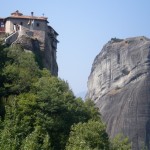Monasteries of Meteora
By Helen Grubner. Filed in Uncategorized |Friday 13 August saw me rise bright and early, keen to move on from Metsovo after a disappointing short stay. No longer very traditional and I feel overrated. Furthermore, I found the standard of food served, poor and expensive.
Left my room at 0840 hours to take a 5 Euro taxi ride to the bus stop below the village, bound for the town of Kalambaka, situated near the famous Monasteries of Meteora. There I met a lovely Greek lady, we started chatting and when the bus eventually arrived, sat together. At first, we travelled along the Motorway and through some of the amazing tunnels I have previously written about, the longest 3.6km! then back to the twisting roads.
Arrived in Kalambaka late morning and found a room at Hotel Meteora www.hotel-meteora.com for 25 Euro a night, including breakfast. A small room but quiet and with air conditioning, absolutely necessary as the heat here at present is almost unbearable. Visited the Laiki (street market) to buy fruit then returned to Taverna Panellinion where my friend Doreen and I ate 6 years’ ago – great food and service. Despite being hot and crowded, Kalambaka has a good feel – Panellinion will be my place of choice to eat and Hollywood Cafe is where I come to use the Internet.
A good breakfast this morning before catching the 0830 hours bus to the Holy Monastery of the Great Meteoron, my plan being to visit four of the six monasteries on a slow walk back down to Kalambaka. Studies suggest that the natural sandstone rock pinnacles were formed around 60 million years’ ago. The first people to inhabit Meteora were hermit monks in the 9th Century, who lived a life of mainly solitude in caves, meeting only on Sundays and special days for worship and prayer, in a chapel built at the foot of a rock known as Dhoupiani.
In 1344, Athanasios Koinovitis from Mount Athos brought a group of followers to Meteora and from 1356 to 1372, he founded the Holy Monastery of the Great Meteoron. The monks were safe from political upheaval as they had complete control of entrance. The only means of reaching there was by climbing long ladders which they could draw up whenever they felt threatened and baskets or large nets were used to haul up both people and goods.
Of the more than twenty monasteries built, beginning in the 14th Century, only six remain today, each with fewer than ten inhabitants. The Holy Monastery of the Great Meteoron is the largest and by far the most interesting one to visit and Varlaam, is the second largest. St. Nicholas Anapausas has wonderful frescoes, decorated by the Cretan painter Theophanis Strelitzas in 1527. There is a 2 Euro entrance fee to each Monastery, each one closes on a different day of the week and they all have different opening hours. To enter, women must wear a skirt below the knees and men long trousers which are provided if you turn up in unacceptable attire.
Today I visited four of the six monasteries, making it back to Kalambaka some five hours after leaving and I’m still recovering. No problem with the legs but with the extraordinary heat, however, pleased to have had the experience.



